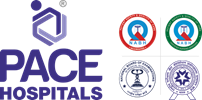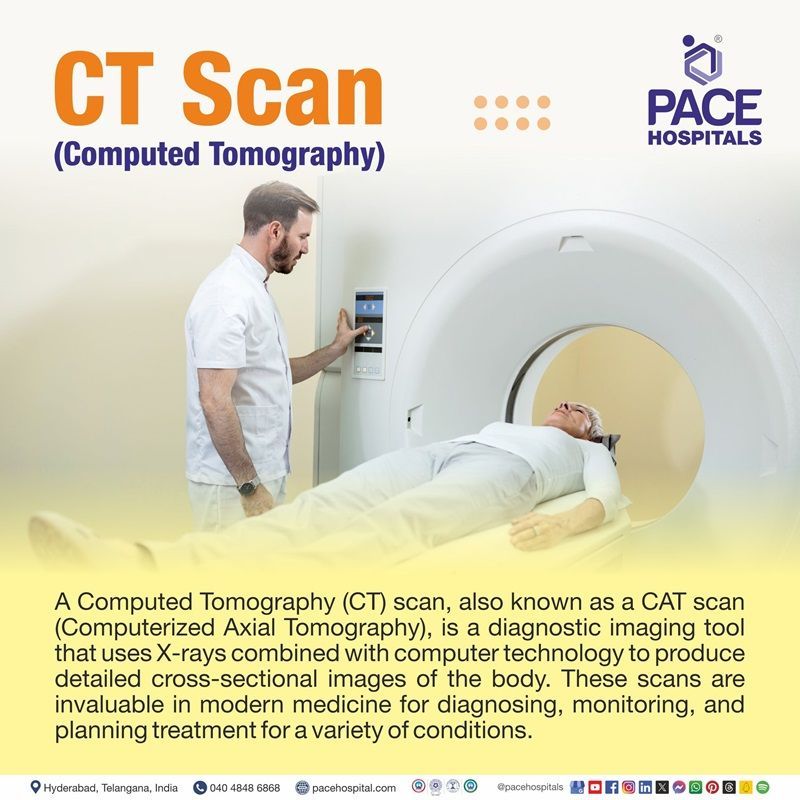Best CT Scan Centre in Hyderabad, India | Advanced Imaging
PACE Hospitals stands out as one of the top CT scan centres in Hyderabad, Telangana, India to offer accurate diagnosis and high-quality imaging. With state-of-the-art multi-slice CT scanners, we ensure high-precision detailed imaging, low radiation exposure, and fast scanning technology for patients across various medical specialties.
Our patient-friendly services, ultra-modern imaging technology, and expert radiology team make us the preferred choice for CT scans in Hyderabad, India. Whether for routine health checkups or emergency diagnostics, trust us for precise imaging and faster results.
Why Choose PACE Hospitals for CT Scans?

Advanced Multi-Slice CT Scanners for high-precision imaging
Best Radiologists in Hyderabad, India ensuring accurate reports
24/7 Availability for emergency and scheduled CT scans
Affordable Pricing & Cashless Insurance Support
What is a CT scan?
A CT scan takes several pictures of the body from various perspectives using cutting-edge X-ray equipment. Computer processing of these images produces intricate 2D or 3D depictions of interior organs, bones, blood arteries, and tissues. The scan provides a clearer and more detailed view than standard X-rays.
CT scan full form and definition
A Computed Tomography (CT) scan, also known as a CAT scan (Computerized Axial Tomography), is a diagnostic imaging tool that uses X-rays combined with computer technology to produce detailed cross-sectional images of the body. These scans are invaluable in modern medicine for diagnosing, monitoring, and planning treatment for a variety of conditions.
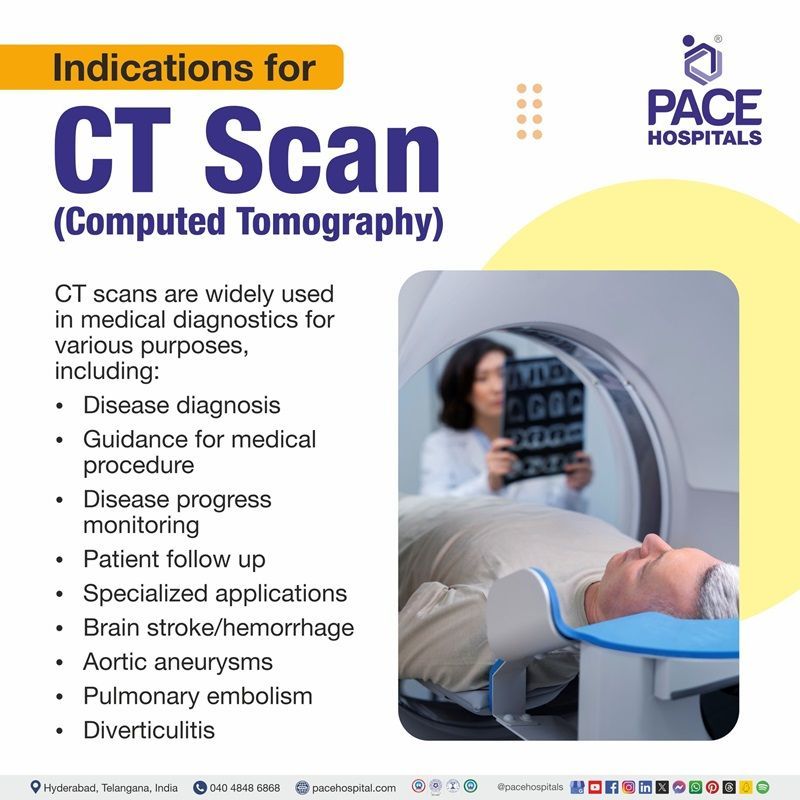
CT Scan Indications
CT scans are widely used in medical diagnostics for various purposes, including:
- Diagnosis of Diseases and Conditions: CT scan is used to detect cancer and stage tumors. In case of infection management, this scan helps in identifying abscesses or areas of the infection. It also helps in assessing the fractures, internal bleeding and organ injuries.
- Guidance for Medical Procedures: CT scan primarily guides placement of the biopsy needle and to planning surgeries.
- Monitoring and Follow-Up: Evaluating treatment progress in cancer or chronic diseases.
- Specialized Applications:
- CT Scan brain: Identifying strokes, brain tumors, or brain hemorrhages.
- Coronary CT Scan: Detecting aortic aneurysms or coronary artery disease.
- Pulmonary: Diagnosing conditions like pulmonary embolism or interstitial lung disease.
- CT scan abdomen: Identifying appendicitis, diverticulitis, or bowel obstructions.
- CT scan for covid: CT scans are valuable in assessing lung involvement in COVID-19, showing characteristic patterns like ground-glass opacities and consolidations. They help evaluate disease severity, monitor progression, and detect complications, especially when RT-PCR results are delayed or inconclusive. However, their use should be judicious due to radiation exposure and limited specificity.
Types of CT Scans
CT scans are specialized based on the body area or condition being examined, including brain, chest, abdominal, cardiac, and musculoskeletal CT. Major types of CT Scan are as mentioned below:
- Conventional CT Scan: Produces a series of individual images (slices) of the area being examined.
- Helical/Spiral CT: Continuous rotation of the scanner allows for faster imaging with detailed 3D reconstructions.
- High-Resolution CT (HRCT): Used for fine-detail imaging, particularly of the lungs.
- CT Angiography (CTA): Uses contrast dye to visualize blood vessels.
- Cardiac CT: Specialized in imaging the heart and coronary arteries.
- PET-CT: Combines positron emission tomography (PET) with CT for metabolic and anatomical imaging.
- Dual-Energy CT: Uses two different X-ray energy levels for advanced tissue characterization.
CT Scan procedure
Procedure before CT scan
Preparation for a CT scan depends on the type of scan being performed and whether contrast dye will be used.
Preparation Steps:
- Clothing and Jewelry: The patient is recommended to wear comfortable clothing and remove metal objects (jewelry, eyeglasses, etc.) to avoid interference.
- Dietary Restrictions: For some scans, fasting for 4–6 hours may be required, especially if contrast dye is used.
- Contrast Dye: The patient should inform their doctor about allergies, especially to iodine or shellfish. Disclosing any medical conditions, such as kidney disease or diabetes is recommended.
- Pregnancy: Pregnant patients should inform the radiologist to minimize radiation exposure to the fetus.
- Hydration: Patients are advised to drink plenty of water before the scan, especially if contrast dye is administered.
Procedure during CT scan
In order to obtain comprehensive cross-sectional images, the patient is placed on a motorized table that glides into the scanner. There, X-ray beams circle around the body. Contrast dye may be used during the procedure to improve visibility in specific locations.
Step-by-Step Process:
- Registration and Briefing: The technician explains the procedure and addresses concerns.
- Positioning: The patient lies on a motorized table, which slides into the CT scanner, a large doughnut-shaped machine.
- Contrast Dye (if applicable):
- Intravenous (IV): Injected into a vein to enhance visibility of blood vessels and organs.
- Oral: Ingested to visualize the gastrointestinal tract.
- Rectal: Administered via an enema for imaging the rectum or colon.
- Imaging: The scanner rotates around the patient, capturing images as the table moves. The patient may be asked to hold the breath briefly to avoid motion artifacts.
- Communication: The technician monitors from a control room and communicates via an intercom.
- Duration: The scan typically takes 10–30 minutes.
Procedure after the CT scan
After the CT scan, patients are monitored for any reactions to contrast dye and encouraged to drink fluids to help flush it from their system. Most can resume normal activities immediately, with results typically sent to the referring doctor within 24–48 hours.
- Post-Scan Monitoring: If contrast dye was used, the patient may be observed briefly for allergic reactions.
- Hydration: The patient is recommended to drink plenty of fluids to help flush out the contrast dye.
- Resuming Activities: Most patients can return to normal activities immediately.
- Follow-Up: Results are analyzed by a radiologist and shared with the doctor for interpretation.
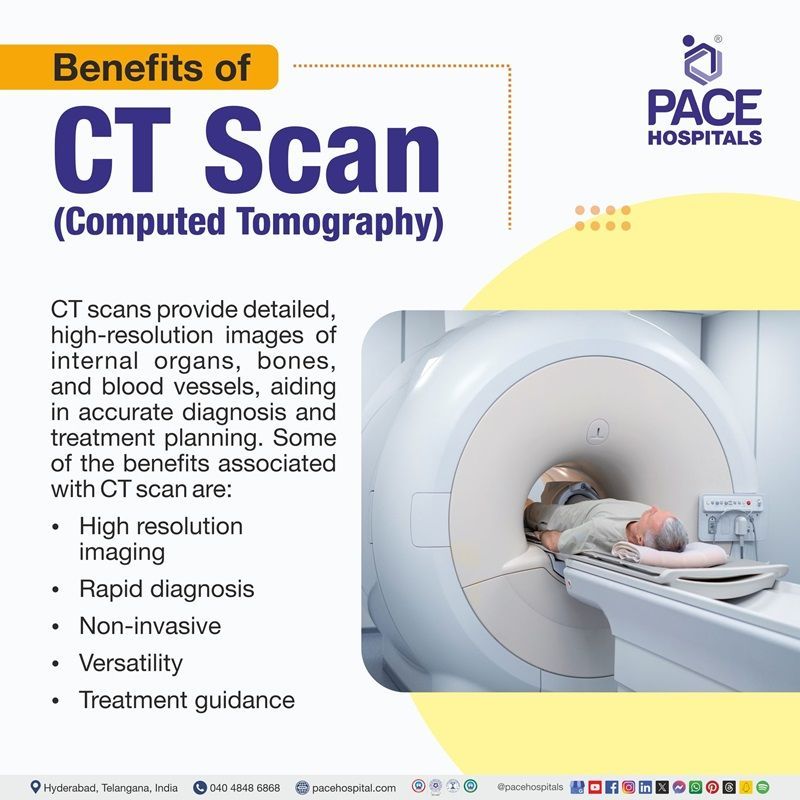
Benefits of CT Scan
- High resolution imaging: Detailed views of organs, soft tissues, and bones are provided via high-resolution imaging.
- Rapid Diagnosis: Particularly in emergency situations, rapid imaging enables timely medical decision-making.
- Non-Invasive: Minimally discomforting when compared to surgical explorations.
- Versatility: Able to diagnose a variety of ailments in different body systems.
- Treatment Guidance: Assists in organizing biopsies, radiation therapy, or procedures.
CT Scan considerations
- Pediatric CT Scans: Lower radiation doses are used for children to minimize long-term risks. Careful positioning and immobilization may be required to prevent motion artifacts.
- Emergency CT Scans: To speed up diagnosis and treatment, scans are carried out in trauma or stroke situations without a prior preparation.
- CT scans for patients who are claustrophobic: Although the scanner is comparatively open, patients who suffer from acute claustrophobia could be given anxiolytic medication or light sedation.
CT Scan risks and complications
While CT scans are generally safe, there are potential risks to consider:
- Radiation Exposure: CT scans involve higher radiation doses than standard X-rays. Cumulative exposure over time may increase cancer risk, though the risk is small.
- Allergic Reactions to Contrast Dye: Symptoms may range from mild (itching, rash) to severe (difficulty breathing or anaphylaxis).
- Kidney Damage: Contrast-induced nephropathy is a rare complication in patients with preexisting kidney issues.
- Pregnancy Concerns: Radiation can pose risks to the developing fetus.
- Overuse: Inappropriate or repeated scans may lead to unnecessary radiation exposure.
Measures to Minimize Risks
- Discuss Alternatives: Explore non-radiation options like MRI or ultrasound when feasible.
- Use of Protective Measures: Lead shields can be used to protect sensitive areas.
- Optimized Protocols: Modern CT machines use low-dose radiation settings.
Advancements in CT Technology
- Low-Dose CT: Used for screening, e.g., lung cancer in high-risk individuals.
- Dual-Source CT: Faster imaging with enhanced detail.
- Artificial Intelligence (AI): Improves image reconstruction and interpretation.
Difference between CT Scan Vs MRI
CT Scan Vs MRI
While both CT and
MRI scans provide detailed images, they differ in the technology used. A CT scan uses X-rays and is ideal for imaging bones, tissues, and detecting internal bleeding, while an MRI uses magnetic fields and is particularly effective for soft tissues like the brain, spine, and muscles. The difference between MRI and CT scan can be broadly explained as below:
| Aspect | CT Scan | MRI Scan |
|---|---|---|
| Technology | X-rays | Magnetic field and radio waves |
| Best for | Bones, lungs, and acute injuries | Soft tissues, brain, spine, joints |
| Speed | Fast (few seconds to minutes) | Slower (30 minutes or more) |
| Radiation | Yes | No |
| Cost | Generally cheaper | Comparatively expensive |
| Contraindications | Pregnancy, radiation sensitivity | Metallic implants, claustrophobia |
Frequently Asked Questions (FAQs) on CT Scan
Is a CT scan safe?
Yes, CT scans are generally safe. However, they involve exposure to a small amount of radiation, which carries a minor risk. For this reason, they are used only when necessary, and the benefits typically outweigh the risks, especially for critical diagnoses.
Can a CT scan detect cancer?
Yes, a CT scan is frequently used to find malignant growths and tumors. It can determine the location, size, and form of tumors in organs such the pancreas, liver, and lungs. Additionally, CT scans are utilized to track cancer metastases.
Can a CT scan be done during pregnancy?
CT scans should be avoided during pregnancy unless absolutely necessary due to the potential risks of radiation exposure to the fetus. If a CT scan is needed, special precautions will be taken to minimize radiation, and alternative imaging methods, like ultrasound or MRI, may be considered.
Can a CT scan detect a heart attack?
A CT scan can be used to detect coronary artery disease, which is a common cause of heart attacks. Specifically, a CT angiogram can assess blockages in the arteries. However, a CT scan alone cannot diagnose an active heart attack; other tests like an ECG are used for that purpose.
Can a CT scan detect stroke?
Yes, a CT scan can detect a stroke, particularly in its early stages. It can identify bleeding (hemorrhagic stroke) or signs of blocked blood vessels (ischemic stroke), helping physicians decide on the appropriate treatment quickly.
How does a CT scan work?
A CT scan works by rotating an X-ray machine around the patient, taking multiple X-ray images from different angles. A computer then combines these images to produce cross-sectional slices of the body, which can be further analyzed to diagnose medical conditions.
Is a CT scan painful?
No, a CT scan is a non-invasive and painless procedure. Patients may experience some discomfort when positioned on the table or during the administration of contrast dye, but the procedure itself involves no pain. The only discomfort comes from remaining still during the scan.
What should I do to prepare for a CT scan?
The preparation depends on whether contrast dye is used or not. You may be asked to fast for a few hours prior to the scan if contrast is required. Notifying your doctor of any allergies, kidney issues, or pregnancy is also very important. Everything composed of metal should be taken out before the procedure begins.
Can dehydration affect liver function tests?
Yes. Dehydration affects liver function tests, which are why the knowledge of the hydration status of the patient is necessary for the doctor before interpreting the results. Patients must avoid unnecessary physical activity, hot, dry environments and any diuretic (urine-inducing) substances such as caffeine. The patient can nevertheless have ample water.
How long does a CT scan take?
A CT scan typically takes between 10 to 30 minutes, depending on the area being scanned and the complexity of the images required. The preparation time and any necessary post-scan monitoring may add to the overall time at the facility.
How does contrast dye affect a CT scan?
Contrast dye helps enhance the visibility of blood vessels, organs, and tissues, making it easier to identify abnormalities. It is usually injected into a vein, swallowed, or introduced rectally, depending on the type of scan being performed. Some people may experience mild side effects, like a warm sensation or metallic taste.
Are there any risks with contrast dye?
While rare, allergic responses to contrast dye are possible. From mild symptoms like rash or itching to more serious reactions like breathing problems, they might be anything. Because individuals with kidney problems may be more vulnerable to contrast-induced nephropathy, pre-screening is essential.
What are the main uses of a CT scan?
CT scans are used to diagnose a wide range of medical conditions, including cancers, internal injuries, infections, strokes, and diseases of the bones, lungs, and abdominal organs. They can also guide surgeries, biopsies, and radiation treatments, making them crucial in both diagnostics and treatment planning.
How much radiation does a CT scan involve?
A CT scan exposes patients to more radiation than a regular X-ray due to the detailed nature of the images. However, the amount of radiation is still considered relatively low, and the benefits of accurate diagnosis generally outweigh the risks, especially in critical situations.
Will I need to do anything after a CT scan?
After a CT scan, you may be advised to drink plenty of fluids, especially if contrast dye was used, to help flush it from your system. If you were injected with contrast, you may be monitored for a short time to watch for allergic reactions. Otherwise, you can resume your normal activities.
What are the types of CT scans?
There are several types of CT scans, including conventional CT, helical (spiral) CT, multi-slice CT, CT angiography, and cardiac CT. Each type serves a specific purpose, such as assessing blood vessels, coronary arteries, or detailed soft tissues in organs like the lungs and brain.
Are CT scans used for routine check-ups?
CT scans are not typically used for routine check-ups due to the radiation exposure. They are generally reserved for diagnosing specific symptoms or conditions. However, low-dose CT scans are used for lung cancer screening in high-risk individuals, such as heavy smokers, under medical guidance.
Can I eat or drink before a CT scan?
If you are undergoing a CT scan that requires contrast dye, you will likely be asked to refrain from eating or drinking for a few hours before the procedure. For other types of CT scans, no dietary restrictions are typically necessary, but it’s best to follow your doctor’s instructions.
How do I get the results of my CT scan?
After your CT scan, the images will be analyzed by a radiologist, who will prepare a report detailing the findings. This report is sent to your referring physician, who will discuss the results with you and explain what they mean in the context of your symptoms and medical history.
What is single photon emission computed tomography?
Single Photon Emission Computed Tomography (SPECT) is a nuclear imaging technique that provides 3D information about the function of organs and tissues in the body. It uses gamma rays emitted by a radiotracer injected into the bloodstream to create detailed images.
